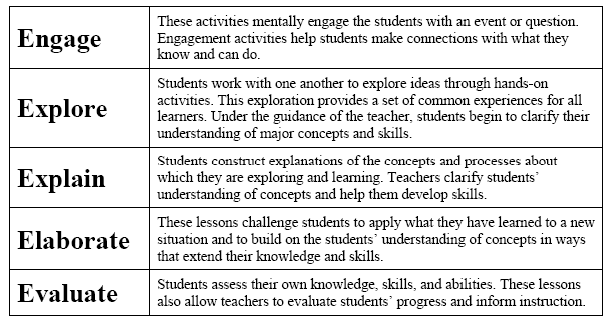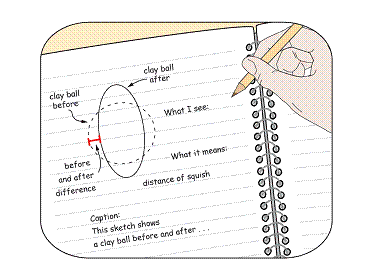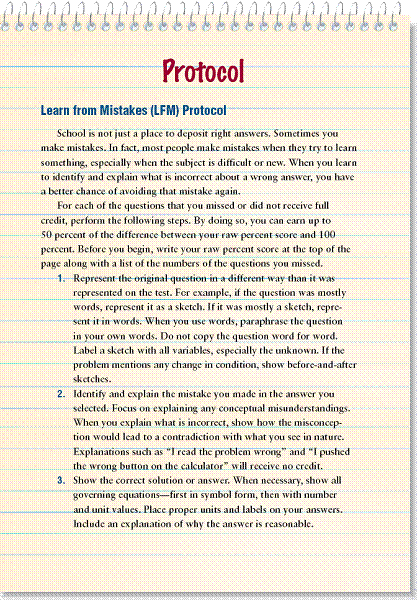Forum on Education of The American Physical Society
Summer 2007 Newsletter
Reformed-Based Physics Teaching: An Inquiry ApproachDave Pinkerton and Betty Stennet
Overview of the program The Biological Sciences Curriculum Study (BSCS) is in the last stages of development of a 3-year multidisciplinary science program for high school. BSCS Science: An Inquiry Approach represents a new generation of instructional materials for high school science. This program, funded by the National Science Foundation, helps students develop an in-depth understanding of the core concepts in physical science, life science, earth-space science, and inquiry as articulated in the National Science Education Standards ( NSES ) (National Research Council [NRC], 1996). Students using BSCS Science: An Inquiry Approach integrate major concepts in science across disciplines and across time in relevant, social contexts. The design of the program is strongly supported by recent research in learning (Bransford, Brown, & Cocking, 2000; Pellegrino, Chudowsky, & Glaser, 2001) Students engaged in BSCS Science: An Inquiry Approach address questions in the core sciences for three years. The three levels of the program address all the high school-level NSES using the conceptual framework shown in figure 1. This program provides high school students and teachers nationwide with a research-based alternative to the traditional sequence of biology, chemistry, and physics that is rigorous, focused, and coherent. Results from field tests suggest that students from a large range of ability levels, from college preparatory students to those with special needs, can be successful with the program. Teachers share many success stories of how students with a range of ability have succeeded in classrooms using BSCS Science: An Inquiry Approach . Outcomes of the program National field tests of the program have demonstrated its effectiveness. Among the findings, two major results highlight the quality and effectiveness of the instructional materials for improving student achievement (figure 2, Coulson, 2002). First, the performance of 1,550 individual students on pre- and posttests were tracked. Tests were developed for 14 chapters, seven per grade level. The results demonstrate strong and statistically significant gains in student achievement. Average student gains at both ninth- and tenth-grade levels were between 20 and 25 percent. Second, a key goal was to evaluate whether students of different ability levels benefited from the curriculum. Results show that classes of "general ability," "high ability," and "mixed" each demonstrated a significant increase from pretest to posttest independent of the ability level of students.
Figure 2: Field test results from portions of Level 1 and Level 2 of the program. The effectiveness of the program is currently being tested in a large-scale, randomized, controlled experiment with several high schools in Florida that have adopted Level 1 of BSCS Science: An Inquiry Approach . This research is funded by a grant from the Department of Education. Key aspects that have made the program successful A key aspect of the program is that laboratory activities are integral to learning science content and inquiry skills. The labs do not appear in a separate (and often viewed as optional) book, but rather are included as an integral part of the learning sequence. The tight coherence between content and active learning experiences helps students know, think, and apply the major understandings of science. Classrooms with this environment blend results from research on learning with the on-the-ground realities of schools to create best practices (Kimmelman et al., 1999; Singer et al. 2005). This program integrates features of research-based, active learning classrooms as naturally as it integrates life science, physical science, and earth and space science. Cognitive development strategies in the program include: the BSCS 5E instructional model (described in figure 3); embedded literacy strategies tied to student readings; multiple forms of representation; metacognition using student notebooks as a tool; questioning strategies designed to engage higher order thinking skills; activities directly targeted to student misconceptions; collaborative learning; and balanced assessments.
Figure 3: The salient features of each E of the BSCS 5E instructional model. In BSCS Science: An Inquiry Approach , each chapter proceeds through a cycle of activities based on the BSCS 5E instructional model. According to the model, each E represents an important part of the sequence through which students progress to develop their understanding. The BSCS 5E instructional model naturally supports the program's inquiry focus. The combination of the 5E model with a strong assessment-oriented design provides opportunities for learning and conceptual change in students, which leads to an improved understanding of science (Bransford, Brown, & Cocking, 2000). Unique aspects of the program Two aspects of this program are unique: essential design principles guided each phase of development, and findings from learning research were integrated into the lesson structure. The essential design principles used to develop this curriculum were the BSCS 5E instructional model, understanding by design (Wiggins & McTighe, 1998), and the National Science Education Standards . Together, these principles applied to curriculum design generate a program that is focused, rigorous, and coherent, all reported aspects of materials that increase student achievement and long-term learning, self-monitored. BSCS Science: An Inquiry Approach applies findings from learning research to orchestrate each lesson. Primarily, this orchestration takes the form of making a select family of literacy strategies explicit and integral to the day-to-day progress through the 5E instructional model. These literacy strategies elicit prior knowledge, foster expert-like conceptual structures, and teach metacognitive habits of the mind. Three examples provide illustration. Including highlight comments and captions on figures, tables, and sketches occurs in each chapter throughout the program. Students generate highlight comments as short phrases to capture the essence of what they see and what it means . For example, one lesson on action-reaction asks two students to place a ball of clay between books they hold. Next, they tap the books together to model a collision and then examine the amount of squish recorded in the ball's shape. The lesson structures students' thinking by first requiring them to write down what they see and link it to a sketch they have made. After this explicit reference to evidence, students interpret what they see by making a brief statement of what it means. Once students check their understanding, they write a caption. Captions translate the highlight comments into a coherent paragraph constructed of cause and effect statements. The caption is a succinct record of student understanding at that point in time. It encourages students to link evidence to explanations - an essential aspect of inquiry (figure 4).
Figure 4: Highlight comments and caption in student notebook. Another unique literacy strategy is used often to help students monitor their learning. The Think-Share-Advise-Revise (TSAR) strategy is often used after students generate highlight comments and a caption. In this reflection and communication strategy, students first think about the answer to some curricular prompt. In the prompt above, students write highlight comments and a caption. Students do this as individuals, thus expressing their individual preconceptions. Next, student pairs share what they have written. They use their work as a prop in explaining their initial ideas. After they share, they advise each other on how to improve each response. Finally, they revise their original response based on the feedback in the share out. Along the way, students record what happens in their notebooks, which teachers can use as formative assessments. After several activities in a chapter in which students generate highlight comments and share their thinking by using TSAR, they are in a position to demonstrate knowledge and understanding. This program uses several performance-based evaluations (class presentations, investigation design, role playing). But it also uses conceptually based multiple choice tests. These tests are an important reality in schooling. In this program, we use a structured learning protocol to help students learn from mistakes on these tests. The protocol is called Learn from Mistakes (LFM). Figure 5 explains the essential features and the sequencing of the LFM protocol. The overriding inquiry concept conveyed to students by the LFM protocol is that acquiring knowledge is always a process. The process often involves situations in which knowledge is not understood completely or accurately. But with time and an insistence on linking evidence to new understanding, learning can develop.
Figure 5: Sample Learn from Mistakes protocol. Suggestions for successful implementation Two preliminary results immerge from studying field test teachers and the few schools that have adopted parts of this program. First, teachers who implement successfully tend to use the teacher edition as it is designed. That design includes rich support for teacher logistics such as detailed materials lists, advanced preparation, and extensive background information for out-of-discipline teachers. More significantly, the teacher edition provides within each step of an activity coherent rational and practical suggestions for teaching so that students construct their own knowledge. Secondly, teachers who understand the BSCS 5E instructional model and the philosophy of the program exhibit high fidelity of implementation. Teachers who fostered a climate of inquiry in their classrooms where students felt safe in expressing their ideas and explaining their thoughts and where students could build their own knowledge through time were the most successful with the program. Lessons learned in developing the program Two important lessons from development should be shared with the physics education community. The first lesson is the need for ongoing and intensive review, both formal and informal. In developing this program, feedback was solicited systematically. For example, field test teachers provided extensive descriptions of their experiences and offered suggestions, which were incorporated into the final product. Evidence from field test student pre- and posttests helped developers modify lessons. Each chapter was reviewed by content experts and text editors twice before publication. Annual advisory board meetings took advantage of the expert feedback from the larger science and science education community. Our development process depended on these frequent formal and informal reviews. The second lesson we learned is the need for several versus a single design conference. Certainly, the overall framework of the program was laid out in the early stages of development. In this framework, we decided the general division of content and inquiry-based organizing principles to use for each level of the program. For example, Level 1 broaches characteristic properties, Level 2 force and motion, and Level 3 energy transformations and disorder. This framework remained constant throughout development. But within each level, BSCS held design conferences to establish the way this framework would manifest. Thus, the writing team positioned themselves to learn from each previous development experience as they moved forward. This learning process made the final three-year program coherent, rigorous, and focused. Conclusion Reformed-based physics curricula can be successfully developed and implemented. To do so requires a clear understanding of how people learn. That understanding leads to teaching students the skills to do scientific inquiry in the context of science content. The BSCS 5E instructional model structures curriculum development so it fosters learning inquiry and content. Along with explicit literacy strategies integral to content activities and richly annotated teacher pages, student achievement increases in both science content and science as inquiry. References Bransford, J., Brown, A., & Cocking, R. (Eds.). (2000). How people learn: Brain, mind, experience, and school. Washington , DC : National Academy Press. Coulson, D. (2002). BSCS Science: An Inquiry Approach-2002 interim evaluation findings. Arnold, MD: Author. Kimmelman, P., Kroeze, D., Schmidt, W., van der Ploeg, A., McNeely, M., & Tan, A. (1999). A first look at what we can learn from high performing school districts: An analysis of TIMSS data from the First in the World Consortium. Washington , DC : National Institute on Student Achievement, Curriculum, and Assessment. National Research Council. (1996). National science education standards . Washington DC : Diane Publishing Company. Pellegrino, J., Chudowsky, N., & Glaser, R. (Eds.). (2001). Knowing what students know. Washington , DC : National Academy Press. Singer, S., Hilton, M., & Schweingruber, H. (Eds.). 2005 America 's Lab Report: Investigations in High School Science. Washington , DC : National Academy Press. Wiggins, G., & McTighe, J. (1998). Understanding by design . Alexandria , VA : Association for Supervision and Curriculum Development. Dave Pinkerton and Betty Stennett are science educators with BSCS. They are part of the team of curriculum developers working on BSCS Science: An Inquiry Approach. Currently Levels 1 and 2 of the program are available commercially through Kendall Hunt Publishing ( www.kendallhunt.com ). Level 3 of the program will be released in 2008. For more information about the program or BSCS please visit www.bscs.org . |
||||||||||||||||||||||||||||||||||||||||||||||||||||||||||




